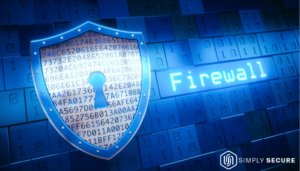FIREWALL – NOT YOUR BEST CYBER DEFENSE (Part 1)

A firewall is a security tool that acts as a barrier between an internal network and the outside world, filtering out unwanted traffic and allowing only authorized traffic to pass through. While a firewall is an essential component of any cybersecurity strategy, it is not enough to rely solely on a firewall to protect your organization from cyber threats. In this article, we will explore why a firewall is not your best cyber defense and what else you can do to protect your organization.

Firewalls have been a critical component of network security for decades, and they remain an important tool in the cybersecurity arsenal. They are relatively easy to set up and use, and they can be configured to block traffic based on IP address, port number, and other criteria. However, a firewall has some limitations that make it an insufficient cyber defense on its own.
First, a firewall cannot protect against all types of cyber-attacks. For example, a firewall cannot prevent a user from clicking on a phishing email that contains malware or entering sensitive information into a fake login page. It also cannot prevent attacks that originate from within the organization, such as a rogue employee stealing data or installing malware on the network.
Second, firewalls can be bypassed by attackers who use techniques such as tunneling, spoofing, or encrypted traffic. Hackers can use legitimate protocols like HTTP or HTTPS to disguise their malicious activity and evade detection by a firewall. They can also use social engineering tactics to trick users into downloading malware or disclosing sensitive information.
Third, firewalls can generate a false sense of security. Many organizations believe that installing a firewall is enough to protect their network, and they do not take additional steps to secure their systems. However, a firewall is just one layer of defense, and it should be complemented by other security measures such as endpoint protection, access control, and user awareness training.

So, if a firewall is not your best cyber defense, what else can you do to protect your organization? Here are some additional steps you can take:
- Implement endpoint protection: Endpoint protection solutions, such as antivirus software and intrusion detection systems, can detect and prevent malware from infecting endpoints, including desktops, laptops, and mobile devices.
- Use access control: Access control solutions, such as two-factor authentication and role-based access, can ensure that only authorized users can access sensitive data and systems.
- Conduct regular user awareness training: User awareness training can educate employees about the latest cyber threats and best practices for staying safe online, such as how to spot phishing emails and how to create strong passwords.
- Regularly patch and update systems: Keeping systems and software up-to-date can prevent attackers from exploiting known vulnerabilities.
While a firewall is an essential component of any cybersecurity strategy, it is not enough to rely solely on a firewall to protect your organization from cyber threats. By complementing a firewall with additional security measures such as endpoint protection, access control, user awareness training, and system updates, you stand a better chance of preventing malicious attacks, when they happen.

Article Written by Kevin Gordon,
CEO of Simply Secure Group
